Concept
| musiCompass focuses on the world
of music. Music is one of the best ways to express emotions and moods as
a performer as well as a listener. Music has been, and continues to be at
the centres of society. Artists create styles of music, people listen to
them and develop identifications; collecting
music, creating play lists and developing a unique music taste are trends
of the time. musiCompass aims to bring people, artists and music together in a visual and interactive environment. |
Concept |
|||
| Based on the idea that there are
patterns in tastes and that tastes are not
distributed uniformly, musiCompass uses collaborative
filtering on profiled music data. Each person is represented by their
music profile, a computer-readable representation
of their listening habits So far data has been collected from around 60.000 users, totaling over 100 million listened songs. musiCompass visualizes resulting connections between people and artists through mapping. People A neighbourhood of people with similar music taste is generated for each listener. An algorithm that compares individual profiles on song level calculates this neighbourhood. Fans of a certain artist represent people with a high interest in this artist and can be used as reference point to find similar artists. Artists A similarity calculation based on the people’s music profile generates connections between similar artists. “People who have listened to these artists have also listened to those artists” is the underlying principle. This network is presented in the music map. Connections between artists and people generate dynamic fields of tastes. |
Design |
|||
|
musiCompass assists with the navigation between
artist and listeners. | |||
| The neighbourhood: The neighbourhood is a visualisation of the connections between a listener’s music taste and the tastes of similar listeners. The distance between the individual listener and his related listeners is a matter of similarity of the music taste profile. The user’s top ten artists are displayed. Furthermore, the activity of the listener (transparency) and the amount of listened songs (size) is shown. |
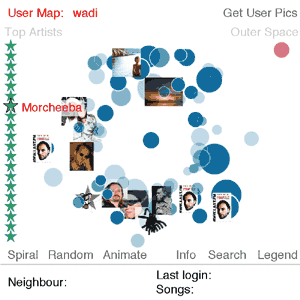 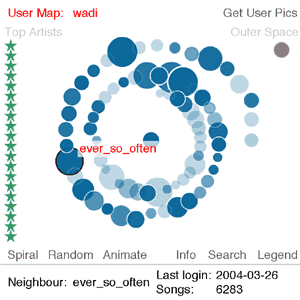 |
||
| The artist
network: The artist network is the visualisation of an artist, similar artists and fans. The distance of a fan from the artist represents the ratio of the fan’s listened songs from this artist to the total amount of listened songs. The size of a fan represents the size of the music profile. |
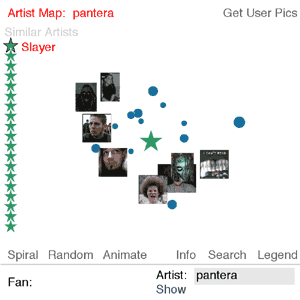 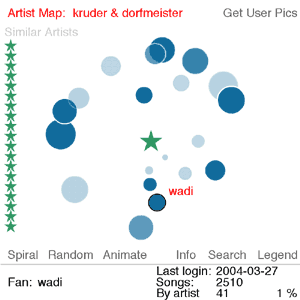 |
||
| The music
map: The musiCompass' main visualisation shows the entire network of artists. The techniques used involve collaborative filtering algorithms that measure the degree of similarity between artists based on all music profiles. Representative artists and music genres/styles have also helped to create a reference map. The music map is used to localize users' taste in the landscape of music, his current position and a path of his listening history. This technique is used to localize all users’ positions on last.fm and audioscrobbler.com. |
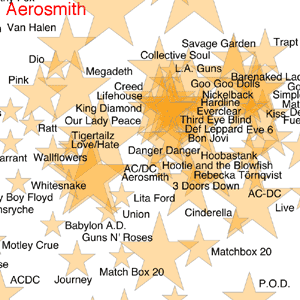 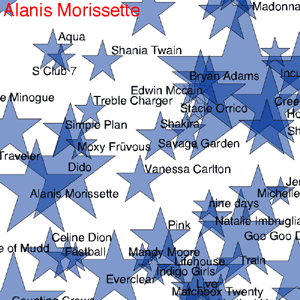 |
||
Technology |
|||
| audioscrobbler: After a user has installed an open source audioscrobbler plug-in, their media player (such as Winamp, iTunes etc) logs what songs they listen to on their PC. This data becomes part of their music profile. |
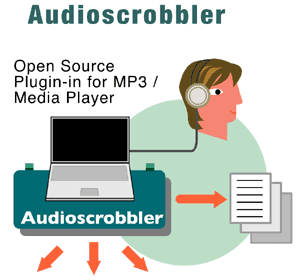 |
||
| last.fm: The last.fm online radio streams music to you and gives you the opportunity to skip the songs you don’t like. As with the audioscrobbler plugin, every song you listen to is added to your music profile. Listening to traditional radio stations does not contribute to your music profile, only songs where the user has control over what they are listening to are counted. |
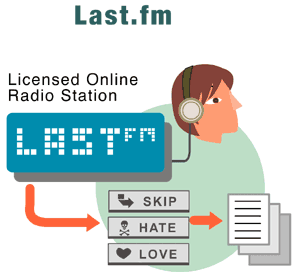 |
||
| Dirk Waldik: The mapping is realised in Macromedia Flash MX; with a distribution of almost 100%, the interfaces are accessible for almost everyone and can be seen as a browser in a browser. Content can be downloaded on demand without refreshing the page in the browser. PHP is used on the server to format the data before sending to Flash. |
|||
Conclusion |
|||
| musiCompass operates outside the
limits of traditional genre classification, the music map is considered
an organic entity that is continually evolving as more music profiles are
added. The more listeners that contribute, the more accurate the map becomes. musiCompass is like an atlas of music, providing a visionary interface for people to explore and exchange individual music taste and to find a community who share their passion in music. People tend to tie their identity to the music they listen to, and musiCompass helps to bring these people together. Expirence the new world of music with musiCompass at <www.audioscrobbler.com> and <www.last.fm> |
|
||
Realisations |
|||
| Latest releases: Implementation of user map and artist map in the new release of last.fm (03-04-2004). User map and artist map display the social network and the connection to the artist as part of the new pop-up player. Development: Music Map - Development of innovative methods to create a map for the entire world of music. Different approaches are involved to analyse and transfer the existing data of artist similarity and neighbourhood calculation for mapping. Semio Music - Analysis of the semantic connections of song titles. Match artists and people by a selection and combination of specific words? History: First version of the neighbourhood and artist network for last.fm |
<user and artist map> <music map> <semio music> <user and artist space> |
||
| Last update: 04-04-2004 by Dirk Waldik |
Contact: compass@wadi.de
Questions, suggestions, ideas and supports are welcome |
||